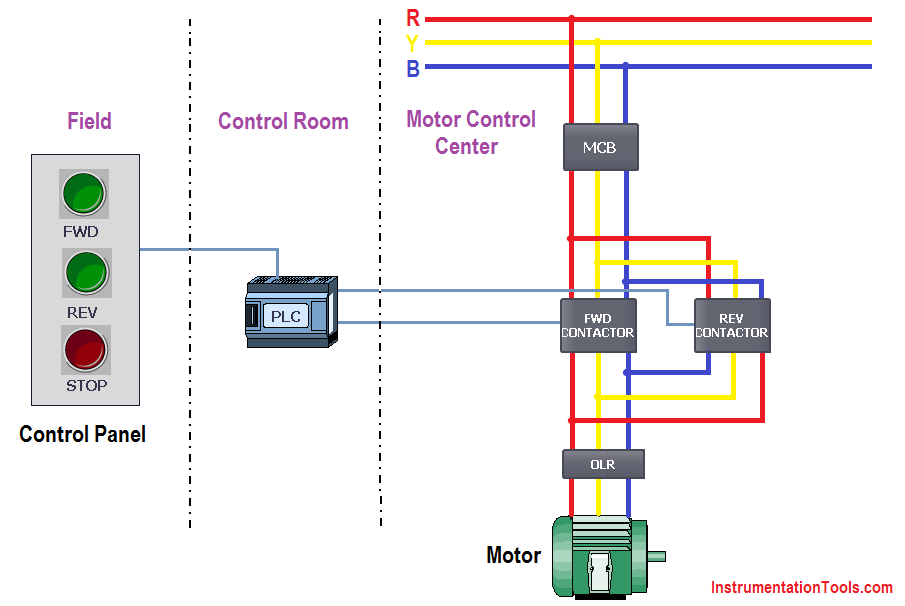

Represented on schematic diagrams as a dotted line between the two coils, a mechanical interlock is a physical barrier that is pushed into the path of one coil’s armature by the movement of the adjacent coil. If both become energized, some form of mechanical interlock is required to prevent both armatures from pulling in. A failure in electrical interlocking can cause both coils to be energized at the same time. The best way to provide this is through electrical interlocks, which prevent the one coil from being energized if the other is engaged. Mechanical Interlocksįorward / reverse starters must never close their power contacts simultaneously. They will also come with two sets of normally closed auxiliary contacts to act as electrical interlocks. If both starter coils became energized simultaneously, a short circuit will occur with potentially hazardous results.įorward / reverse starters will come with two sets of normally open auxiliary contacts to act as holding contacts in each direction. Note that the two contactors must be electrically and mechanically interlocked so that they cannot be energized simultaneously.
FORWARD AND REVERSE MOTOR CONTROL DIAGRAM FOR CRANE SERIES
The return paths for both starter coils connect in series with the normally closed contacts of the overload relay so that if an overload occurs in either direction, the starter coils will be de-energized and the motor will come to a stop. Since the two motor starters control only one motor, only one set of overload relay heaters need be used. When the reverse contactor is energized, the power contacts connect line L1 to T3, line L2 to T2 and line 元 to T1 at the motor. When the forward contactor is energized, power contacts connect line L1 to T1, line L2 to T2 and line 元 to T3 at the motor. Each of the two different motor starters powers the motor with a different phase rotation. If a motor is to be driven in two directions, then it will require a Forward / Reverse motor starter, which has two three-pole horsepower-rated contactors rather than just one as in the conventional starter. This is known as reversing the phase rotation.


Once two of the lines have been switched, the direction of the magnetic fields created in the motor will now cause the shaft to spin in the opposite direction. This can be done at the motor starter or at the motor itself. If a three-phase motor is to be driven in only one direction, and upon its initial energization it is found to be rotating opposite to what is desired, all that is needed is to interchange any two of the three line leads feeding the motor. There are six safety measures in the circuit design: Start button interlocking, output q0.1 and q0.2 interlocking, external contactor KM1 and km2 interlocking, falling edge to ensure that the switch is released before the signal is connected, main circuit safety application to achieve short circuit protection, overload relay to achieve overload protection, six safety measures.Circuits 36 Forward/Reverse Control Circuits Please experience the application fun along the command for beginners. Its reliable action is to cut off the reverse rotation when it is pressed, and then start the forward rotation after it is released, so as to realize the safe and reliable forward reverse conversion. The action is: when the forward start button i0.2 is pressed - the open point of i0.2 is connected - the close point of i0.2 is disconnected - ensure that the reverse output q0.2 is cut first - the close point of q0.2 is connected - when the i0.2 button is released - its falling edge signal is connected - the output of q0.1 is connected and self-protection - realize forward operation. The following procedure: when the reverse output q0.2 is working, switch to the forward mode, so that the output of q0.1 is 1, The use of PLC falling edge command and switch interlock mode can reliably ensure that when the forward or reverse switch is pressed, the output of the other direction can be cut off first, and the required direction output can be connected only after letting go. We know that the safest problem of the motor forward and reverse control circuit is that the forward and reverse transfer contacts must not be switched on at the same time, otherwise 380V direct short circuit accident will occur. Today, we introduce a case of direct and reliable switching motor forward and reverse program. Learning PLC, along the application of instructions is indispensable, it brings us a lot of convenience programming.


 0 kommentar(er)
0 kommentar(er)
